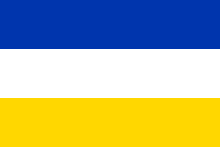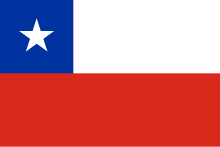Flag of Chile: Difference between revisions
m Reverted edits by 205.213.92.64 to last version by A More Perfect Onion (HG) |
No edit summary |
||
| Line 1: | Line 1: | ||
{{Refimprove|date=October 2007}} |
{{Refimprove|date=October 2007}} |
||
{{Infobox National flag |
{{Infobox National flag |
||
| Name = |
| Name = bong pipe |
||
| Image = Flag of Chile.svg |
| Image = Flag of Chile.svg |
||
| Nickname = ''La estrella solitaria'' |
| Nickname = ''La estrella solitaria'' |
||
Revision as of 15:13, 20 October 2008
This article needs additional citations for verification. (October 2007) |
 | |
| La estrella solitaria | |
| Use | National flag and ensign |
|---|---|
| Proportion | 3:2 |
| Adopted | October 18, 1817 |
| Designed by | Antonio Arcos |
The national flag of Chile, also known as La estrella solitaria (Spanish for "the lone star"),[1] consists of two equal horizontal bands of white (top) and red and a blue square the same height as the white band at the hoist-side end of the white band, which bears a white five-pointed star in the center. It was adopted on October 18, 1817.
The star represents a guide to progress and honor; blue symbolizes the sky and the Pacific Ocean, white is for the snow-covered Andes, and red stands for the blood spilled to achieve independence.
First Chilean flag

During Chile's struggle for independence, the government of José Miguel Carrera called for the creation of a national flag, the first one for the country. On July 4 1812, the flag was raised for the first time during a banquet celebrating the independence of the United States (this event having a great influence on the locals' struggle for independence). The banquet was held by the United States Consul, Joel Roberts Poinsett. A little time after, on September 30 of that same year, the seal and flag of the Old Country (La Patria Vieja) were adopted. The banner represented the three powers of the State: Majesty, Law, and Strength. Nevertheless, this flag didn't survive the Old Country and in May of 1814, upon the signing of the Treaty of Lircay, Colonel Francisco de la Lastra, enemy of Carrera, commanded that the flag be taken down and replaced by the Spanish flag. It was last used in the battle of Rancagua, October 1-2 1814, that started the Reconquest (Reconquista). During this period, Chile didn't have a flag.[citation needed] The Liberator Army (El Ejército Libertador), organized in Argentina, fought at the battle of Chacabuco under the flag of the Army of the Andes.[citation needed] The defeat of the spanish rule, in February 12 1817, signified the end of the Realist control and the beginning of the New Country (La Patria Nueva). Afterwards the Spanish flag was no longer used.
Second Chilean flag

After the triumph of Chacabuco, on May 26 1817, a new banner was adopted called the Flag of the Transition (Bandera de la Transición). This flag had three stripes: blue, white, and red, this last one replacing the yellow from the flag of 1812. Its design is attributed to Juan Gregorio Las Heras. These colors had their origin in the verses of Alonso de Ercilla that say: por los pechos, al sesgo, atravesadas, bandas azules, blancas y encargadas, attributed to the warrior traits of the Mapuches during the Conquest (la Conquista). The red symbolized the heroes' blood shed on the field of battle; the white, the snow of the Andes range; and the blue, the Pacific Ocean by the Chilean coast. The colors were also the ones of the French Revolution, an event that inspired many revolutionaries in America. As with the Old Country's flag, this one was never official and disappeared five months later. Among other reasons, it was easily confused with the flag of the Netherlands and France.
Third and current Chilean flag

Today's Chilean flag was conceived by Bernardo O'Higgins's Minister of War José Ignacio Zenteno and designed by Antonio Arcos, although some claim that is was Gregorio de Andía y Varela who drew it. This model, made official on October 18, 1817, was used during the oath of Independence. In 1854 the proportion of each flag color was set and in 1912 the star diameter was established.
There is a rather popular legend in Chile that claims this third Chilean flag won a "Most Beautiful National Flag in the World" contest. Its main variation states that this happened in 1907 in Blankenberghe, Belgium, in the coast of the Baltic Sea [sic].[2] Other variations on this story say this happened in the 19th century, or that the Chilean flag was placed second after the French flag; there are even variations that talk about Chile's national anthem, placing it either in the first place or second, after La Marseillaise. The fact that the only documented version of this story gets basic details wrong (Belgium has a coast on the North Sea but not the Baltic Sea) doesn't reflect well on its historical accuracy.
Similar flags
- The flag of the U.S. state of Texas is similar to the Chilean flag, which was created and introduced 21 years before that of Texas. The Texas flag has a blue side that covers the left 1/3 of the whole flag. Chilean's blue part one, covers a smaller part of the flag.
- The first flag of the Confederate States of America, known as the Stars and Bars, has similarities as well, though it has three bars, two red and one white as opposed to one red and one white. Also, instead of one star, it includes a number of stars reflecting the states in that short lived republic.
- The Flag of Liberia has certain similarities; it also includes a single star on the canton, though it includes multiple stripes similar to the United States Flag.
Displaying the Chilean flag
According to Chilean law, citizens are required to and may only display the flag on National Day holiday (September 18) and Army Day (September 19). If the flag is displayed incorrectly or not displayed at all during these days, police may fine the person responsible.
On a Pole
The flag pole must be white and the flag must hang from the top of the pole. If the Chilean flag is displayed with those of other countries, they should all be of equal size and raised to the same height. Also in this case, the flag should be raised first and lowered last.
Freely Hanging
The Chilean flag can be displayed hanging either vertically or horizontally from a building or wall. In both cases, the blue square should be to the viewer's upper left.
Respect due to the flag
Article 22 of the Constitución Política de la República de Chile de 1980 states that all inhabitants of the Republic owe respect to Chile and to its national emblems. The national emblems of Chile are the national flag, the coat of arms of the Republic and the national anthem. Pursuant to article 6 of the State Security Act of Chile (Decreto No. 890 de 1975), it is a felony against the public order to publicly mistreat the flag, the coat of arms, the name of the motherland or the national anthem.
References
- ^ Claudio Navarro. "Símbolos: La Bandera" (in Spanish). Retrieved 2008-06-08.
{{cite web}}: Unknown parameter|coauthors=ignored (|author=suggested) (help) - ^ "La bandera chilena ganó concurso internacional" (in Spanish). 1907-10-06. Retrieved 2007-08-30.
{{cite web}}: Check date values in:|date=(help)
